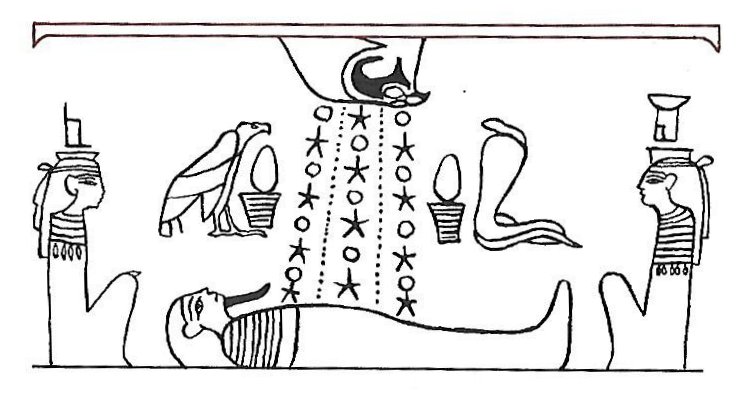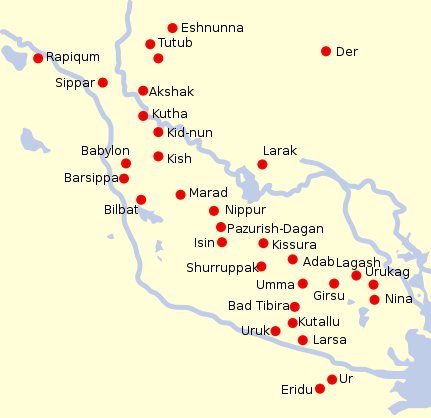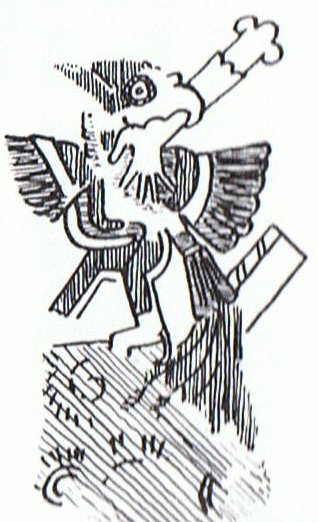137. This formidable Mayan illustration of the White-bone-snake shows there was a pair of open jaws, twinned together, and perhaps one was for the Sun and another one for a pair of Full Moon faces:
... The manik, with the tzab, or serpent's rattles as prefix, runs across Madrid tz. 22 , the figures in the pictures all holding the rattle; it runs across the hunting scenes of Madrid tz. 61, 62, and finally appears in all four clauses of tz. 175, the so-called 'baptism' tzolkin. It seems impossible, with all this, to avoid assigning the value of grasping or receiving. But in the final confirmation, we have the direct evidence of the signs for East and West. For the East we have the glyph Ahau-Kin, the Lord Sun, the Lord of Day; for the West we have Manik-Kin, exactly corresponding to the term Chikin, the biting or eating of the Sun, seizing it in the mouth.
These pictures (from Gates) show east, north, west, and south; respectively (the lower two glyphs) 'Lord' (Ahau) and 'grasp' (Manik). Manik was the 7th day sign of the 20 and Ahau the last ... ... But in the fullness of time an obscure instinct led the eldest of them towards the anthill which had been occupied by the Nummo. He wore on his head a head-dress and to protect him from the sun, the wooden bowl he used for his food. He put his two feet into the opening of the anthill, that is of the earth's womb, and sank in slowly as if for a parturition a tergo. The whole of him thus entered into the earth, and his head itself disappeared. But he left on the ground, as evidence of his passage into that world, the bowl which had caught on the edges of the opening. All that remained on the anthill was the round wooden bowl, still bearing traces of the food and the finger-prints of its vanished owner, symbol of his body and of his human nature, as, in the animal world, is the skin which a reptile has shed ... In the C text we found Alcyone at Cb2-6 with the 'sky canoe' separated from Mother Earth below: ... We can perceive the gap in Cb2-6 as an illustration of the gap here forced upon between the upside down sky bowl and the world below - receiving the benefits of rain and beams from the Sun. South of the equator November was a spring month corresponding to May in the north.
But now we must adjust this interpretation slightly after having noted the existence of twin rivers where Cetus aquired his legs to be used up on the Land of 'Meso-potamia' - the land between the quick as an arrow Tigris River and his slowly moving black Brother carrying good sweet water (Eu-phrat). This was where Lulal and Latarak had stood guard - one of them with a whip and the other one presumably with a club because Pollux had wielded such a weapon.
... During his descent the ancestor still possessed the quality of a water spirit, and his body, though preserving its human appearance, owing to its being that of a regenerated man, was equipped with four flexible limbs like serpents after the pattern of the arms of the Great Nummo. The ground was rapidly approaching. The ancestor was still standing, his arms in front of him and the hammer and anvil hanging across his limbs. The shock of his final impact on the earth when he came to the end of the rainbow, scattered in a cloud of dust the animals, vegetables and men disposed on the steps. When calm was restored, the smith was still on the roof, standing erect facing towards the north, his tools still in the same position. But in the shock of landing the hammer and the anvil had broken his arms and legs at the level of elbows and knees, which he did not have before. He thus acquired the joints proper to the new human form, which was to spread over the earth and to devote itself to toil ...
The figure standing in Cb2-5 has a broken arm in front and evidently Alcyone marked where the Sun once upon a time had made abrupt contact with Mother Earth.
|
||||||||||||||||||||||||||||||||||||||||||||||||||||||||||||||||













